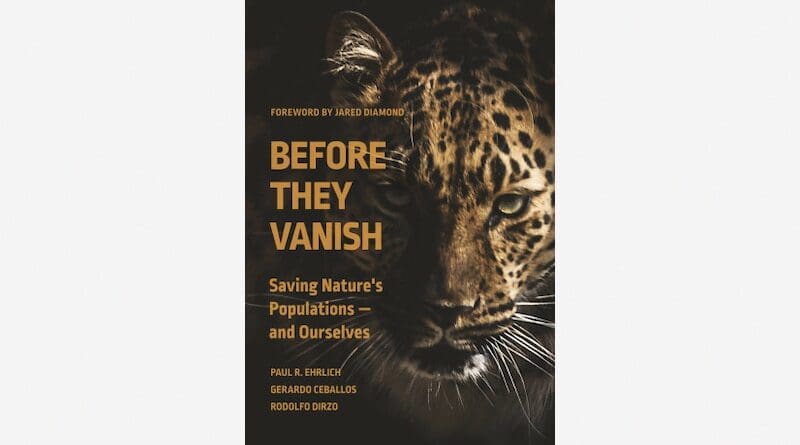‘Before They Vanish’ Addresses The Crisis Of Species Loss – Book Review

"Before They Vanish: Saving Nature's Populations — and Ourselves," by Paul R. Ehrlich, Gerardo Ceballos, Rodolfo Dirzo
September 22, 2024
By Eurasia Review
No oncologist would wait for a patient’s cancer to spread before treating it. Similarly, waiting to detect the potential loss of a species across all its known habitats means interventions are often too late to turn the tide of extinction, according to ecologists Paul Ehrlich and Rodolfo Dirzo of Stanford University and Gerardo Ceballos of the National Autonomous University of Mexico. Their new book, Before They Vanish: Saving Nature’s Populations – and Ourselves, calls for earlier detection and mitigation of threats to ward off population extinction – the loss of plants, animals, fungi, or microbes within specific geographic areas. The approach provides a greater chance at stopping the spread of species loss, according to the authors.
Drawing on decades of research and experience, the authors explain how humanity is pushing countless species to the brink of extinction, with devastating consequences for ecosystems and human civilization. They highlight how conservationists have tended to focus on saving iconic animals, such as tigers and eagles, on the brink of extinction – primarily for ethical and aesthetic reasons. It is only relatively recently that biodiversity’s crucial role in supporting human life has been appreciated by the scientific community, according to the authors. The book serves as both a diagnosis and a plea for action, outlining solutions to avert a global ecological catastrophe.
Below, Ehrlich, Dirzo, and Ceballos discuss their new book, their decades in the field, and their hope for the future.
What are some of the cascading effects of population extinctions – the loss of a species in a specific geographic location – that may not be immediately obvious to the public?
Rodolfo Dirzo: Look at the combined impact of deforestation, poaching, and hunting on the populations of elephants, giraffes, and other large herbivores in African savannas. The local loss or decline of these vertebrates’ populations not only leads to the decline of prey for carnivores but triggers major vegetation changes – more grass and shrubs. These changes in turn create a perfect storm for small mammal populations, particularly rodents, to thrive. Many of these are host to zoonotic disease agents that could spark outbreaks among people.
How do you respond to potential criticism that focusing on population-level extinctions could divert resources from protecting critically endangered species?
Gerardo Ceballos: Conservation requires focusing on both population and species levels. Protecting critically endangered species means protecting their last populations. However, focusing on population-level extinctions means maintaining populations at regional and national levels, preventing further deterioration of declining species, and maintaining ecosystem services at those levels. For example, maintaining elephant populations in South Africa will help conserve the species in the continent while preserving the benefits to both ecosystems and the human well-being of that country.
Your work spans decades of research. What changes in extinction patterns or conservation approaches have you observed over your careers?
Paul Ehrlich: In my 70-plus years in conservation, I have seen the scientific community slowly come to realize that the true “wealth of nations” is their biodiversity – the only type of capital that human beings cannot survive without. My scientific surprise has been the discovery, partly in my research, of the “insect apocalypse” – the massive destruction of insect populations. Among other things, that is a major factor in the decline of bird populations.
Dirzo: Our work has drawn attention to the fact that biodiversity conservation efforts need to consider policy intervention to prevent the extinction of ecological interactions. For example, the loss of populations in an ecosystem can lead to the local extinction of processes such as pollination or pest control. Also, biodiversity conservation is being increasingly recognized as a critical factor of societal well-being in terms of human health, including disease regulation and mental health.
If readers take away just one action item from your book, what would you want it to be?
Dirzo: Changing human behavior away from unsustainable meat consumption and industrial agriculture. This represents an action that will reduce massive land-use change, greenhouse gas emissions, personal health afflictions, waste, and inequity.
Ceballos: A very important action is to vote for the politicians that have conservation as a major issue in their political agenda.
Given the accelerating rate of land-based vertebrate losses, what gives you hope that we can still make a meaningful difference?
Ehrlich: Humanity has shown the ability to change behavior very swiftly when people feel threatened. One of the chores of scientists is to be sure that everyone understands that civilization cannot persist on its current trajectory.
Ceballos: Many successful conservation cases at all levels indicate that the current extinction crisis is not predetermined.
No comments:
Post a Comment